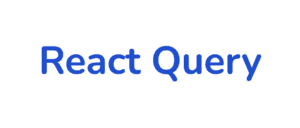Are you weighing your options between React Query vs Redux for effectively managing state in a React application? Both libraries have their unique benefits, but which one is best suited to meet your requirements? This blog post examines the differences between these two popular choices, offering up insights that will help guide you toward making an educated decision.
First, we’ll explore the fundamentals and capacities of both React Query and Redux libraries. We’ll then compare their size, performance, usability, and ecosystem. By the end of this post, you should be able to make a well-thought-out decision between these two options that best fit your next project based on their strengths and weaknesses.
What is React Query?

React Query helps your React application efficiently handle data with its outstanding features of data fetching, caching, and asynchronous actions. This lightweight library was designed by Tanner Linsley and maintained by the contributions of the open-source community.
Automatic Caching
React Query is revolutionary in its capacity to cache and invalidate data based on query parameters automatically. This functionality ensures that when you make multiple data fetch with the exact requirements, React Query will only produce a single network request while supplying cached outcomes for the following requests.
This feature can significantly improve the performance of your application, particularly when associated with the stale-while-revalidate strategy. It allows your React app to display stale data while retrieving new information in the background, creating a seamless user experience.
Intuitive API
React Query simplifies handling asynchronous operations, for example, making updates to your data. It uses a concept called “mutations” that keeps you in control by tracking the loading, success, and error states of your modifications. This feature makes updating information faster, more straightforward, and more efficient while reducing boilerplate code.
Architecture
React Query stands out from other state management libraries due to its focus on optimizing data queries. While libraries like Redux and MobX efficiently manage global application states, React Query is purposely designed for quickly fetching and caching API calls. This intention makes it an excellent choice for applications that rely heavily on server communication and need an easy solution for improving data retrieval performance.
What is Redux?

Redux, a library developed by Dan Abramov and Andrew Clark, is widely used for handling state in JavaScript applications. Although Redux works with any view library, it is usually integrated with React to provide developers with a robust data management solution for React applications.
Principle
Redux operates on the principle of a unidirectional data flow, where actions are delivered to reducer functions that update the app’s state accordingly. The global app state is stored in an immutable “store” entity, which can only be modified by triggering an action and allowing it to go through the reducer. This technique helps create clear boundaries between how components present themselves and the state management logic, granting you a more straightforward way to debug and test your application.
Middleware
Redux’s unique middleware system allows you to intercept and customize actions as they pass through the reducer. It is ideal for logging, error handling, or connecting with asynchronous APIs. Additionally, Redux has a comprehensive collection of plugins and integrations, such as Redux Thunk, Redux-Saga, and ReSelect, which make it an optimal choice for large-scale projects that require more advanced features.
Learning Curve
Although Redux is a powerful tool for state management, its learning curve is steeper than other libraries and requires more boilerplate code. It is also more opinionated and may not be the best fit for every application.
Comparing React Query vs Redux
With a basic understanding of React Query and Redux, let’s now dive into the differences between these two libraries.
Functionality
When comparing React Query and Redux, one of the significant differences is in terms of functionality scope. React Query concentrates on data fetching and caching, while Redux supplies a comprehensive client-side state management solution. Therefore, if your application depends heavily on API calls with an emphasis on optimizing data fetching and caching efficiency, consider using React Query as your go-to solution. However, for more complex projects that call for serious client state management capabilities, Redux might be the way to go.
Usability
React Query offers a much more straightforward API and requires less boilerplate code than Redux. Nevertheless, Redux’s strict unidirectional data flow simplifies testing and debugging in large projects.
Scalability
React Query and Redux both perform well in large-scale applications when evaluating scalability. However, Redux is the winner due to its strict separation of concerns and middleware system that may make it easier to manage complex apps over time.
Bundle Size
While using React Query, you only need to install a standalone library. The current version of React Query (as of 2023) is around 13kB minified and gzipped.
Before @reduxjs/toolkit, it required a few separate libraries to integrate Redux into a React project. You must install at least three libraries: redux, react-redux, and a middleware to handle async actions such as Redux Thunk or Redux-Saga. That doesn’t even include popular third-party packages in a typical React Redux project, such as reselect for memorization or immer for normalization.
However, @reduxjs/toolkit was created with all necessary functions included, so you don’t need to install any extra libraries. That’s why the Redux documentation recommends using it instead of Redux core. So, now you only need to install two packages to use Redux:
@reduxjs/toolkit: 13.5kB minified + gzippedreact-redux: 4.7kB minified + gzipped
It is clear that React Query’s bundle size is a bit smaller than Redux. While this difference may be insignificant for smaller applications, it can add up in larger applications with many dependencies.
Performance
React Query is often seen as faster and more lightweight than Redux due to its small size and concentration on data fetching. That said, the @reduxjs/toolkit provides excellent features for performance improvement with memoization and normalization strategies; plus, the middleware system offers greater control over the app’s data flow.
Nevertheless, it’s crucial to acknowledge that the performance of your application does not only depend on a state management library’s size and capabilities. It also heavily relies on other factors like code efficiency and app complexity.
Community and Ecosystem
React Query is a relatively new library released in late 2019. However, it has gained a strong following among developers and has a growing community of contributors and users. On the other hand, Redux has been around since 2015 and has a well-established community of contributors and users.
Regarding the ecosystem, React Query is a complete solution, so you don’t need any plugins. In contrast, if you want to use Redux core, Redux has a large and mature ecosystem with a broad range of plugins and integrations available.
Pros and Cons
This section summarizes the pros and cons of React Query and Redux to help you decide which library is the best fit for your needs.
Pros of React Query
- Lightweight and fast, with a focus on data fetching and caching
- Simple API and minimal boilerplate code
- Automatic data caching and invalidation based on query parameters
Cons of React Query
- Relatively new and may have a smaller community and ecosystem compared to other libraries
- Primarily focused on data fetching and caching, and may not be suitable for complex client state management requirements
Pros of Redux
- Well-established library with a large community and ecosystem
- Strict unidirectional data flow can make it easier to reason about and debug your application
- Middleware system allows for more granular control over the data flow in your application
- Has a wide range of integrations and plugins available
Cons of Redux
- May have a larger size and performance overhead compared to other libraries
- More opinionated than some other libraries and may not be a good fit for every application
- Can have a steeper learning curve and require more boilerplate code to set up
Use Cases of React Query and Redux
Here are a few examples of when you might choose one library over the other:
- If your application relies heavily on data fetching and caching, React Query offers a convenient solution that is both lightweight and simple to use – making it the optimal choice.
- If your application needs more complex state management or you desire more profound control over the data flow, then Redux may be a better solution.
- If you are building a small, simple application and want to minimize the amount of boilerplate code, React Query may be the way to go.
- If you are building a more extensive and complex application and want a library with a robust ecosystem, Redux may be a better choice.
It is worth mentioning that React Query and Redux can work together in the same application when desired. This way, you can have the power of both libraries while organizing your state management system according to your project’s demands.
However, it is critical to remember that too many state management libraries can lead to a complex and overloaded codebase. To get the most effective results, choose one comprehensive solution that meets your application’s needs rather than trying to combine multiple libraries.
Conclusion: Choosing the Right Library for Your Next Project
React Query and Redux are two widely-used libraries that can help you manage data fetching, caching, and asynchronous actions in a React application. While they both accomplish these tasks effectively, their approaches differ significantly.
React Query is the perfect solution for small-to-medium, data-driven applications that require efficient and reliable fetching and caching. This library has a user-friendly API with minimal boilerplate code.
Redux is the ideal solution for state management in some sophisticated applications. Redux gives users ultimate control over their project’s data flow thanks to its unidirectional data flow and powerful middleware system. Moreover, it works seamlessly with React and has plenty of plugins and integrations.
When deciding between React Query and Redux for your application, it is beneficial to consider the advantages and disadvantages of each library as well as their bundle size, performance level, and ecosystem. You must take into account what specific requirements are necessary to make an informed decision.
You may consider reading another analysis about React Query vs RTK Query. RTK Query is an optional add-on contained in the Redux Toolkit bundle. This fantastic tool provides a seamless way to quickly access, manipulate, and cache data for your application.

